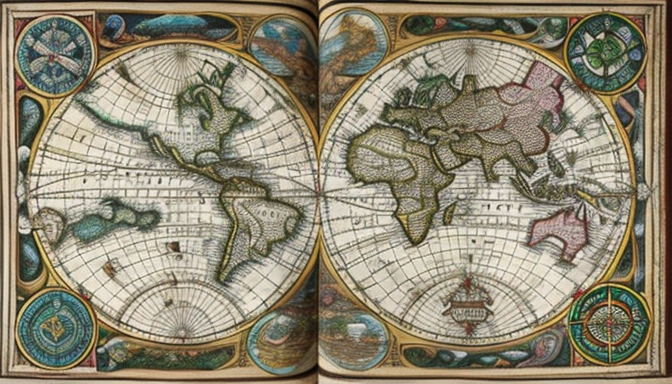When we dive into the enchanting realms of fantasy literature, one of the most captivating elements is undoubtedly the maps. These intricate illustrations do more than just depict geography; they breathe life into the worlds we explore, allowing us to traverse vast kingdoms and treacherous terrains without ever leaving our seats. Imagine flipping through the pages of your favorite fantasy novel, your eyes wandering over the sprawling lands, mysterious forests, and towering mountains. Each line drawn on these maps is a thread in the tapestry of the story, weaving together the history, culture, and adventures that await.
Maps serve as crucial tools in world-building, transforming abstract ideas into tangible landscapes. They help readers visualize the relationships between different realms, the challenges of navigating vast oceans, or the perils of crossing treacherous mountain ranges. Without these visual cues, the narrative could easily feel flat, lacking the depth and richness that a well-crafted map provides. Think of maps as a key to unlocking the secrets of a fantasy world, guiding us through the mysteries and legends that lie within.
In the realm of fantasy cartography, the possibilities are as limitless as the imagination itself. From the majestic peaks of the Dragonspine Mountains to the eerie depths of the Shadowlands, each map tells a story of its own. So, next time you pick up a fantasy novel, take a moment to appreciate the artistry behind the map. After all, it’s not just a drawing; it’s an invitation to embark on an unforgettable adventure!
The Role of Maps in World-Building
Maps are not just pretty pictures; they are the very backbone of fantasy literature. Imagine diving into a new world without a clue about its geography! Maps serve as crucial tools in guiding readers through the intricate landscapes of fictional realms. They offer a visual representation that pulls readers deeper into the narrative, allowing them to explore kingdoms, traverse mountains, and navigate forests. This immersion is essential for creating a believable and engaging story.
When crafting a fantasy map, the design of landforms and the delineation of realms can significantly influence the story’s flow. For instance, imagine a kingdom bordered by treacherous mountains and vast oceans. Such natural barriers shape not only the geography but also the culture and history of its inhabitants. The layout of the map can hint at conflicts, trade routes, and alliances, enriching the narrative with layers of meaning.
Moreover, the intricacies of kingdom borders can reflect political tensions and historical events. A well-thought-out map can reveal:
- Ancient battle sites
- Trade routes that connect different cultures
- Mythical locations that hold significance in the lore
In essence, maps are a storyteller’s canvas, allowing authors to paint vibrant pictures of their worlds. They invite readers to embark on a journey where every corner turned and every hill climbed holds a new adventure waiting to unfold.

Techniques for Crafting Fantasy Maps
Creating a fantasy map is akin to conjuring an entire universe from thin air. It’s not just about drawing lines and shapes; it’s about breathing life into the realms you envision. One of the first techniques mapmakers often employ is hand-drawing. This traditional method allows for a personal touch, where artists can infuse their imagination directly onto paper. Think of it as sculpting with ink; every mountain ridge and river bend tells a story.
But in our digital age, digital design has become an invaluable tool. Software like Adobe Illustrator or specialized mapping tools such as Wonderdraft can transform a mere sketch into a vibrant, detailed map. These platforms offer features that let creators play with textures, colors, and even elevation, making the landscapes feel more tangible and immersive.
When crafting these maps, it’s essential to consider various elements that enrich world-building. For instance, landforms like mountains, valleys, and forests not only define geography but also influence the culture and history of the inhabitants. Kingdom borders, too, are significant; they can reflect political tensions or alliances, shaping the narrative that unfolds within your world. To illustrate this, consider the following table:
| Element | Impact on World-Building |
|---|---|
| Mountains | Natural barriers, influencing trade and culture |
| Rivers | Life source, settlements often grow around them |
| Forests | Home to mythical creatures, often shrouded in mystery |
| Kingdom Borders | Reflect power dynamics and historical conflicts |
Ultimately, the art of map-making is about more than just geography; it’s about crafting a narrative that invites readers to explore and engage with your world. So, whether you’re sketching with a pencil or clicking away on a digital canvas, remember that every line you draw is a gateway to adventures yet to come!
Frequently Asked Questions
- Why are maps important in fantasy literature?
Maps are essential in fantasy literature as they provide readers with a visual guide to the complex worlds authors create. They help readers navigate through different regions, understand cultural contexts, and appreciate the history that shapes the story.
- What techniques can I use to create my own fantasy maps?
Creating your own fantasy map can be a thrilling adventure! You can use techniques like hand-drawing, digital design software, or even online map-making tools. Experiment with different styles, such as topographical or artistic, to find what best suits your narrative.
- Can I use real-world geography when designing fantasy maps?
Absolutely! Many fantasy maps draw inspiration from real-world geography. You can mimic the landscapes of your favorite places or blend elements from various locations to create something entirely unique. Think of it as a recipe where you mix and match ingredients!
- What should I consider when placing locations on my map?
When placing locations, consider the story’s flow and the relationships between different places. Think about how geography affects travel, trade, and conflict. It’s like setting up a game board where every piece has a role to play!

Recent Comments